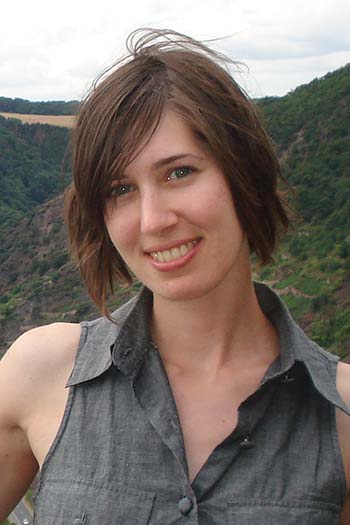
Cara Lubner
Researcher V-Chemistry
Cara.Lubner@nrel.gov
303-384-7765
 https://orcid.org/0000-0003-1595-4483
https://orcid.org/0000-0003-1595-4483
Google Scholar
ResearchGate
In 2011, Cara Lubner received her Ph.D. in Chemistry from the Pennsylvania State University while working under the guidance of John Golbeck to create a solar hydrogen-producing bionanodevice. She joined NREL research staff in 2015 and is a senior scientist in the Redox Biochemistry Group.
Research Interests
Cara’s research interests are centered on the fundamental properties of biological electron transfer, including how the protein environment controls electron and proton transfer events to affect light-driven, multi-electron and electron bifurcation reactions. Of particular interest is elucidating the underlying mechanistic principles that govern electron transfer reactions.
Cara has technical expertise in the use of biochemical and spectroscopic techniques (ultrafast and steady state ultraviolet-visible absorption and fluorescence, electrochemistry, and electron spin resonance) to investigate mechanistic details of electron bifurcating enzymes, and the energy transduction pathways following the absorption of light energy in photosynthesis.
Her broader interests lie in the integration of these fundamental insights toward improving catalytic materials and biocatalysis.
Affiliated Research Programs
Photosynthetic Energy Transduction, U.S. Department of Energy (DOE) Basic Energy Sciences (BES), Photosynthetic Systems (co-lead)
Biological Electron Transfer and Catalysis, Energy Frontier Research Center, DOE BES (co-principal investigator)
Areas of Expertise
Redox biochemistry, biophysical characterization, flavoenzymes, metalloenzymes, and spectroscopy
Cyanobacterial photosynthesis
Application of time-resolved optical spectroscopic techniques to complex biological redox systems
Education
Ph.D., Chemistry, The Pennsylvania State University
B.S., Chemistry, University of Florida
Professional Experience
Senior Scientist, NREL, Biosciences Center (2018–present)
Senior Research Associate, Renewable and Sustainable Energy Institute, University of Colorado, Boulder (2018–present)
Scientist III, Biophysical Chemist, NREL, Biosciences Center (2015–2018)
Research Associate, Renewable and Sustainable Energy Institute, University of Colorado, Boulder (2014)
Featured Work
A New Era for Electron Bifurcation, Current Opinion in Chemical Biology (2018)
Mechanistic Insights into Energy Conservation by Flavin-Based Electron Bifurcation, Nature Chemical Biology (2017)
Electron Bifurcation: Thermodynamics and Kinetics of Two-Electron Brokering in Biological Redox Chemistry, Accounts of Chemical Research (2017)
Equilibrium and Ultrafast Kinetic Studies Manipulating Electron Transfer: A Short-Lived Flavin Semiquinone Is Not Sufficient for Electron Bifurcation, Journal of Biological Chemistry (2017)
The Electron Bifurcating FixABCX Protein Complex from Azotobacter vinelandii: Generation of Low-Potential Reducing Equivalents for Nitrogenase Catalysis, Biochemistry (2017)
Additional Publications
Bacteria 'Read' Light to Gain a Competitive Advantage, Journal of Bacteriology (2019)
The Catalytic Mechanism of Electron-Bifurcating Electron Transfer Flavoproteins (ETFs) Involves an Intermediary Complex with NAD+, Journal of Biological Chemistry (2019)
Distinct Properties Underlie Flavin-Based Electron Bifurcation in a Novel Electron Transfer Flavoprotein FixAB from Rhodopseudomonas palustris, Journal of Biological Chemistry (2018)
Electron Bifurcation Makes the Puzzle Pieces Fall Energetically into Place in Methanogenic Energy Conservation, ChemBioChem (2017)
Activation Thermodynamics and H/D Kinetic Isotope Effect of the Hox to HredH+ Transition in [FeFe] Hydrogenase, Journal of the American Chemical Society (2017)
Chapter 12: In Vitro Light-Driven Hydrogen Production, in Microalgal Hydrogen Production: Achievements and Perspectives (2017)
Reduction Potentials of [FeFe]-Hydrogenase Accessory Iron-Sulfur Clusters Provide Insights into the Energetics of Proton Reduction Catalysis, Journal of the American Chemical Society (2017)
Chapter 11: Re-Routing Redox Chains for Directed Photocatalysis, in Biohydrogen (2015)
Quantum Yield Measurements of Light-Induced H2 Generation in a Photosystem I-[FeFe]-H2ase Nanoconstruct, Photosynthesis Research (2014)
Two-Dimensional Protein Crystals for Solar Energy Conversion, Advanced Materials (2014)
Solar Hydrogen-Producing Bionanodevice Outperforms Natural Photosynthesis, Proceedings of the National Academy of Sciences (2011)
Wiring Photosystem I for Electron Transfer to a Tethered Redox Dye, Energy and Environmental Science (2011)
Chapter 17: Wired Reaction Centers, in Molecular Solar Fuels (2011)
A Novel Photosynthetic Strategy for Adaptation to Low-Iron Aquatic Environments, Biochemistry (2011)
Wiring an [FeFe]-Hydrogenase with Photosystem I for Light-Induced Hydrogen Production, Biochemistry (2010)
Wiring Photosystem I for Direct Solar Hydrogen Production, Biochemistry (2010)
Maximizing H2 Production in Photosystem I/Dithiol Molecular Wire/Platinum Nanoparticle Bioconjugates, Dalton Transactions (2009)
Photosystem I/Molecular Wire/Metal Nanoparticle Bioconjugates for the Photocatalytic Production of H2, Journal of the American Chemical Society (2008)
Chemical Rescue of a Site-Modified Ligand to a [4Fe-4S] Cluster in PsaC, a Bacterial-Like Dicluster Ferredoxin Bound to Photosystem I, Biochimica et Biophysica Acta (BBA) - Bioenergetics (2007)
Share

